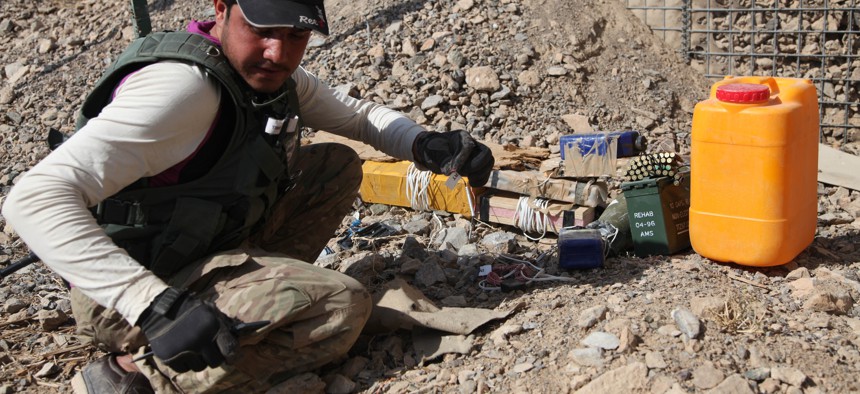
An Afghan Civilian Mine Removal Group (CMRG) member investigates IEDs during a training simulation in Panjwai district, Kandahar province, Afghanistan, Nov. 19, 2013. U.S. Army photo by Pfc. Andrew Miller
The Pentagon Wants to Buy That Bomb You’re Building in the Garage
DARPA will pay tinkerers to weaponize off-the-shelf items — in hopes of defending against such hacks.
Can you rig your toaster into an improvised explosive device or turn a cheap hobby drone into a weapon of mass destruction? The Pentagon would love to hear from you.
On Friday, the Defense Advanced Research Projects Agency, or DARPA, announced that they would award money to people who can turn consumer electronics, household chemicals, 3-D printed parts, cheap drones or other “commercially available technology” into the next improvised weapon.
“For decades, U.S. national security was ensured in large part by a simple advantage: a near-monopoly on access to the most advanced technologies. Increasingly, however, off-the-shelf equipment developed for the transportation, construction, agricultural and other commercial sectors features highly sophisticated components, which resourceful adversaries can modify or combine to create novel and unanticipated security threats,” the agency wrote in a press release announcing the Improv program.
The broad agency announcement, or BAA, puts almost no limit on the scope of the technology that engineers can use in their exploration. It’s an unusual BAA, as they go, specifically designed to catch the attention not just of favored defense contractors but also “skilled hobbyists.” So get your mad scientist hat out, but don’t break the law.
“Proposers are free to reconfigure, repurpose, program, reprogram, modify, combine, or recombine commercially available technology in any way within the bounds of local, state, and federal laws and regulations. Use of components, products, and systems from non-military technical specialties (e.g., transportation, construction, maritime, and communications) is of particular interest,” the BAA says.
Also, don’t just mail your toaster bomb in and expect your reward. The program has three phases. First, submit a plan for your prototype and, if DARPA likes it, or rather, finds it terrifying enough, they’ll give you $40,000. A smaller number of participants will be selected to go on to phase two where they will build their device or system with $70,000 more in possible funding. The top candidates here will go on to a final phase for a more in-depth analysis of their invention or system, a big military demo of how your device or system could give the military a very bad day.
It’s not the first time that DARPA has tried to get into the minds of would-be attackers by offering financial reward. Case in point: the Prediction Analysis Market, or PAM, which was an online prediction casino for the intelligence community. The 9/11 attacks exposed what some called a lack of imagination among the intelligence community. PAM allowed operatives as well as informants or sources within the broader intelligence community to bet on the likelihood of assassinations, coups, and other events of geopolitical importance. The project, conceived of by retired Rear Adm. John Poindexter, was canceled after lawmakers called it “grotesque” and some argued that it might actually inspire the very plots it had been designed to predict.
Time has since vindicated the use of prediction markets and other, sometimes controversial, red-teaming efforts to roleplay potential adversaries. Improv is only the latest.
“DARPA often looks at the world from the point of view of our potential adversaries to predict what they might do with available technology,” program manager John Main said in the release on Friday. “Historically we did this by pulling together a small group of technical experts, but the easy availability in today’s world of an enormous range of powerful technologies means that any group of experts only covers a small slice of the available possibilities. In Improv we are reaching out to the full range of technical experts to involve them in a critical national security issue.”




